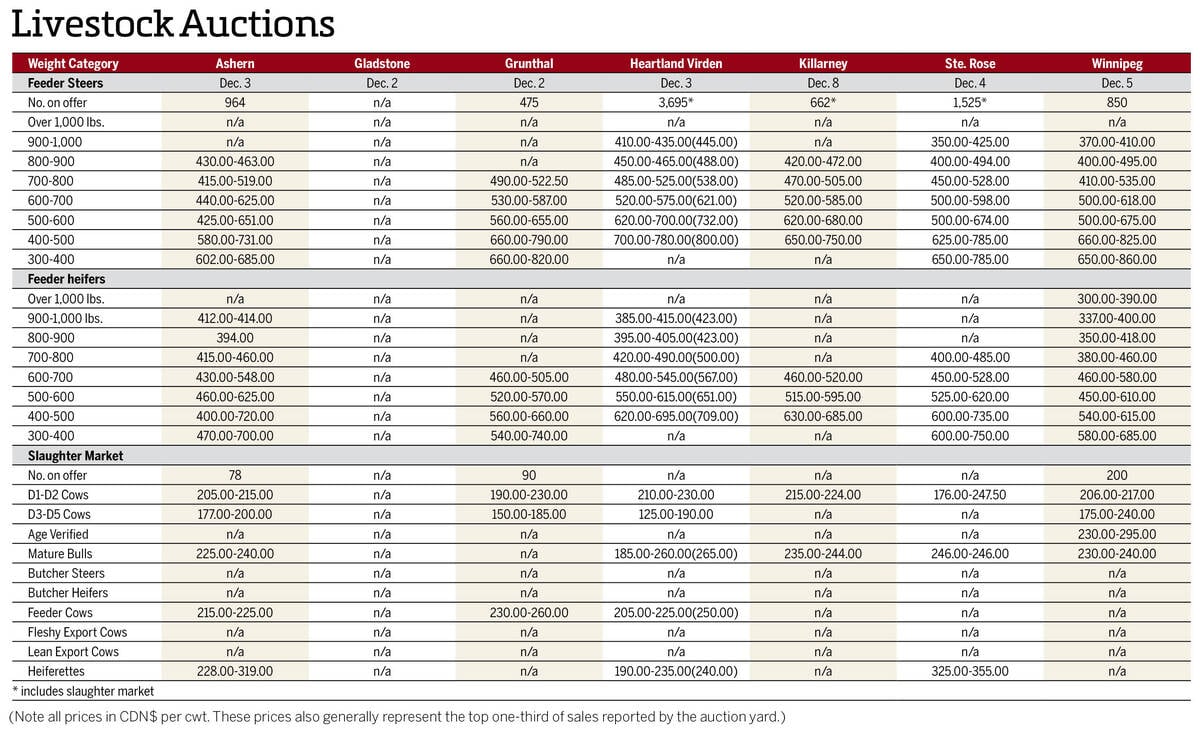Droughts always teach (or remind) us of things we need to be prepared for to maintain health and production in our herds, including ways to access feed and, if need be, marketing.
The Beef Cattle Research Council (BCRC) recently put on a very good question-and-answer webinar relating to drought concerns and cattle health. Here are some of my thoughts on the topic:
We have already seen high temperatures with increased water consumption. On very hot days, water consumption can go to roughly 1-1/2 times what it would be on, say, a 20 C day. Water storage and output of wells were all tested to their maximum during the heat wave.
Read Also

Manitoba cattle prices Dec. 10
Weekly cattle prices from Manitoba’s major livestock auction sales Dec. 3-Dec. 10.
Post-drought, there is a greater need to keep an eye on water quality. From algal blooms to TDS (dissolved solids) and sulphates tying up things such as copper, it is wise to check water, especially if levels have really decreased. If water quality is bad, signs include a sudden decrease in consumption, diarrhea or neurological signs. You might also see cattle staggering.
The first thing to do would be to change the water source. If signs are spotted early and the cattle removed from the bad water source, they often respond quickly. However, death from blue-green algae poisoning is very sudden, and cattle will be found really close to the water source.
Even water quality in wells can change. Watch for water lines being clogged with sediment. When there is increased demand, it is a great time to check out water bowls, access to dugouts or functionality of solar pumps.
Heat stress and lower feed quality may lead to lower conception rates. Was breeding occurring right at the heat wave or was the fetus only three to seven weeks along? Both are critical times with regards to conceiving or maintaining the pregnancy.
For those producers who normally don’t pregnancy check, this would be an extremely good time to start. Those who preg check early can remove open cows, decreasing the load on the pasture and this will reduce winter feed needs. Simple math says that if there is a 10 per cent open rate, then removing those cows will cut the feed requirements for winter by 10 per cent.
It is also a good time to do a deep cull of old, poor-footed, poor-uddered or poor-performing cows, as these conditions usually only get worse. Again, if done early, you have some flexibility in marketing and feeding in the feedlot to up body condition may be a possibility. There are a few larger marketers who specialize in cows, which can help with that procedure.
Another way to save pasture and get better condition on your cows is to early wean the calves. This is especially so if the calves are weaned at home, as you can keep health outcomes good.
Also be on the lookout for weeds in the pasture that don’t look right. Cattle will often graze them when other forage gets short — from water hemlock in the wet areas to horsetail and larkspur, which have toxins in them. Remember that a lot of other weeds, such as tansy and stinkweed, can cause problems if consumed in excess.
Disease conditions such as clostridial disease and anthrax could appear. Make sure that clostridial disease vaccinations are up to date and, if anthrax ever has been reported in your area, that is something to keep in mind. They have predicted a high year for it, but I personally have only heard of one suspect case (in a sheep).
However, the main month for this issue is later summer.
Both vaccines are very efficacious, but the anthrax vaccine immunity only lasts about six to eight months (some bison producers double the dose to increase immunity to around 10 months). Cattle can be vaccinated quickly if diagnosed and the cattle moved off that pasture to decrease losses.
Alternate feeds or drought-damaged feeds are worth pursuing.
Ideally, you should have a feed analysis done and, if they are available, go for those options. If grazing standing grain, there is the worry of grain overload. This is something we seldom see in cattle anymore, with total mixed rations and feeding twice to three times daily. Strip and controlled grazing of this grain land would be necessary.
If there is access to straw, it can also be fed maybe up to 1-1/2 per cent body weight, but grain needs to be added to make this ration work. One always worries about straw impaction, so always watch for cows getting huge on both sides of their flanks and very little manure coming out. This often occurs when cows get very thin. Straw has lots of fibre and very little protein or energy.
Canola crops will have issues with low selenium and vitamin E levels when fed. Sulphates can even get high in canola and tie up selenium. The white muscle condition might develop, so we have lots to watch for. Get ideas from consultants you may use such as veterinarians, nutritionists or others.
















